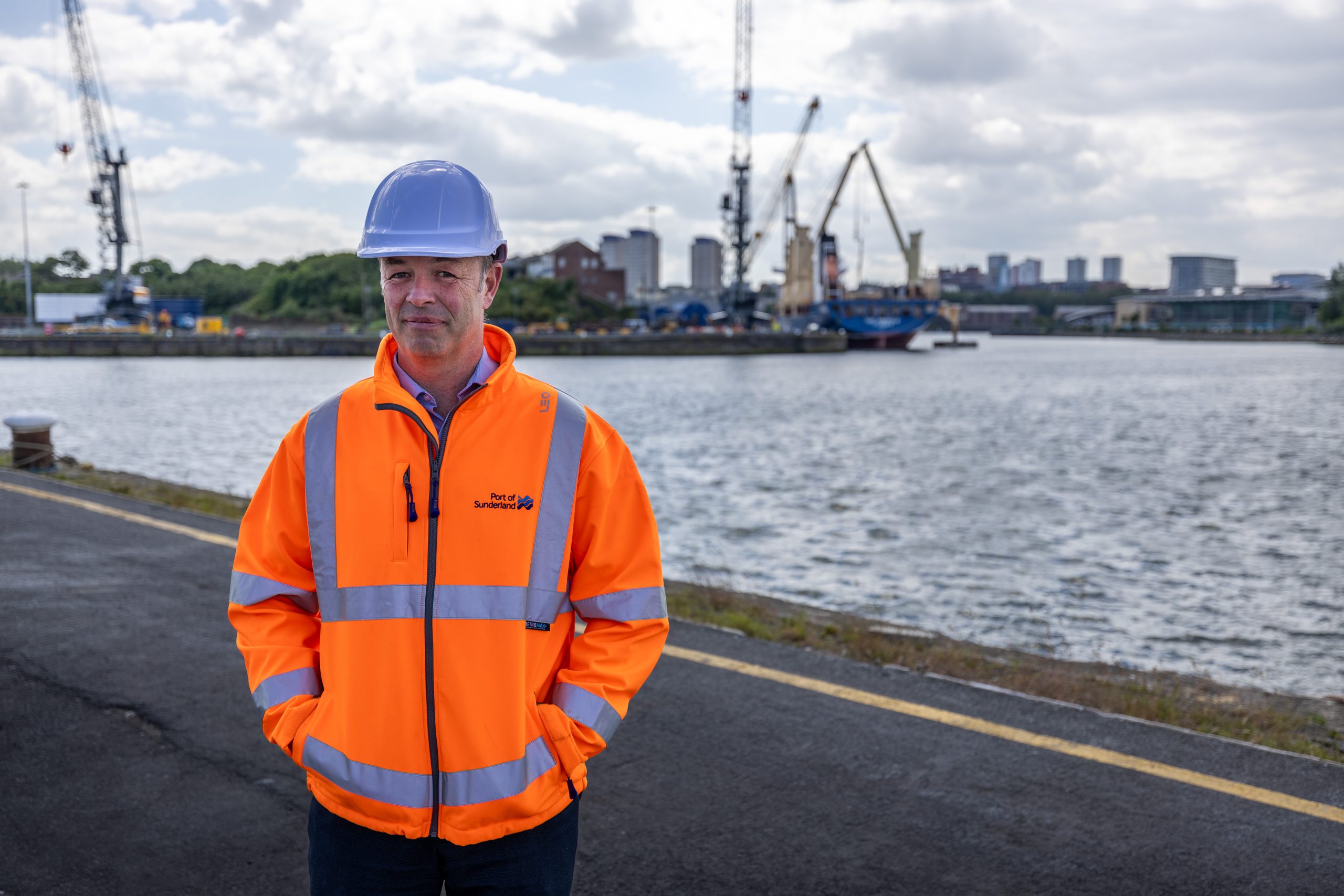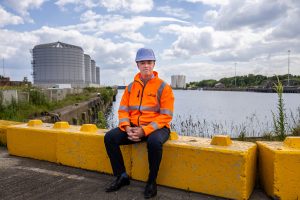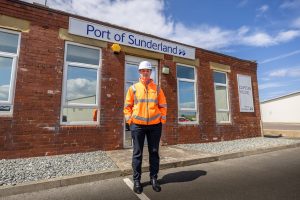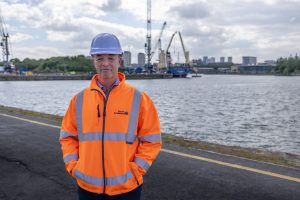Port of Sunderland: ‘So much potential to do something even bigger’

Sven Richards has discovered his sea legs, he’s placed his feet firmly under the desk in Capstan House and found his home at the heart of Port of Sunderland, writes Colin Young.
No wonder.
The Wearside port’s new commercial manager is, he admits, ‘passionate’ about the industry.
And he knows a good port when he sees one.
Transformed over the last decade, Port of Sunderland is now one of the country’s leading municipal-owned ports.
And it is thriving and busy, backed by significant investment from a range of private sector businesses.
“I love ports,” says Sven, who is now a few months into his tenure on Wearside after three years as Port of Workington’s port manager and nine years as port operations manager at Port of Tyne.
“I’ve worked in the industry for over a decade, and this place is unrecognisable from the Port of Sunderland I knew when I worked up the road at Port of Tyne.
“It’s definitely exciting times.
“It’s a privilege and an honour to work here, and a genuinely exciting time for the port and the city.
“The port is doing really well, but there is so much potential to do something even bigger.
“I’m passionate about how the port industry can support the country’s net-zero ambitions, for example, because ports are inter-modal hubs, where we can massively take vehicles off the road and reduce our carbon footprint.

“Fifteen to 20 years ago, people would have said regional ports were not particularly relevant; ships were getting bigger and they were containerising more and more goods.
“We brought goods into Felixstowe from Rotterdam, and they would be trucked around the country because fuel was cheap, drivers were cheap and there wasn’t much of a cost.
“It’s a great thing the port is owned and operated by Sunderland City Council because it’s our window to the world; you just wonder how much more we can do to support the economic regeneration of Sunderland and what’s going on in the city.
“It’s really impressive what’s happening in Sunderland – and the new bridge for the city will be coming through this port on barges and we’ll support with that project.”
Tucked away in a corner of Sunderland, hidden behind the security gates and offices, red and white barriers and foreboding spiked railings, lies the sprawling Port of Sunderland.
Behind it, a city transforming and building for a brighter future; to the east, the gateway to the North Sea. And opportunities.
The harbour at Sunderland is believed to date back to Roman times, and has been established as a port since the early 18th century when the River Wear Commissioners constructed the first buildings and bridges on the site – some of which survive to this day.
There are plans for some of the Victorian buildings to be restored to former glories – there are plans across the whole of the 265-acre site.
Sven, who has been brought in to assist port director Matthew Hunt, is well versed in the port’s history, and the nod and protection of its past is no accident.
He knows he has joined at one of its most important and exciting phases and that the port is ready to play its part in Sunderland’s future.
The port was boosted by a number of substantial investments prior to Sven’s arrival, but there are further announcements in the pipeline.
On North East Times’ tour of the site, past the large silos, huge warehouses and flattened industrial land, Sven took us by some of the major facilities and investments made in recent times by Leo Group, Brineflow, Quantafuel, Wastefront and ASCO, to name just a few.
Quantafuel has made a £150 million investment alone to develop its processing plant, which will turn soft plastics into sustainable aviation fuel; Wastefront has ploughed £100 million into doing the same with some of the 395,000 end-of-life tyres that are annually exported from the UK.

The waters were still as we ambled past, but deep beneath the calmness, Kawasaki has been developing unmanned submersible vessels, which will be able to repair pipelines and damaged underwater structures.
And he showed off the area set aside for a Liebherr LH60 materials handler and JCB telehandler, which aim to improve vessel turnaround time and improve the port’s handling capabilities with bulk and unitised goods.
We travelled beside the tracks of the completed Trinity Rail, Road & Sea Enterprise Zone, which was reinstated nine years ago and plays a major role in the access to rail, road and sea.
“Port of Sunderland is becoming the heart of the UK’s circular economy,” says Sven.
He says: “There is always something bubbling away, which are linking together.
“Leo Group takes the heat off its tanks for the rest of the site, and we are looking into potentially delivering that for the city of Sunderland as well.
“Regional ports are well connected by road, sea and rail – and we prove that when we bring in steel slabs from Scunthorpe on trains; we offload them into the port and we can transport up to 2000 tonnes of slabs on to trains, which go up to Gateshead for processing.
“That’s a lot of truck movements we’ve just taken off the road immediately, and we can use the land and our connectivity to help the net-zero ambitions of the country.”
As well as ensuring the wheels of industry turn across the site, Port of Sunderland provides a vital service in keeping the waters around the city safe.
From April, patrol boats have been monitoring stretches of the River Wear and coastal areas, particularly during busy holiday and weekend periods and when there are increasing numbers of surfers, paddle boarders and people seeking thrills, spills and pleasure trips.
Until September, two boats – Sentinel and Patrol – will keep watch from South Biddick to Wearmouth Bridge, out to the harbour and twin piers.
Sven says: “The idea is to reduce the amount of issues the port has, and it’s part of our statutory responsibility about river safety, which we take very seriously.
“We’re not only a statutory authority, we’re responsible for the safe navigation and operation of the approaches of the river and the harbour.
“We have four pilots who bring the ships in and out, and we regulate all the pleasure craft as well.”
The whole port complex is believed to employ around 500 people, and with its expansion comes ambition to increase the workforce, and the appeal of the industry.

Sven doesn’t find it difficult to sell his port to visitors, both new and old.
And the man with a Port of Amsterdam pen on his desk in Capstan House has the ambition to put Sunderland firmly on the map.
He also knows the sector can provide a career for life.
He says: “Every day is always completely different – and you feel you are still supporting industry throughout the country and the world.
Sven adds: “I still feel we’re part of building and assisting what happens throughout the country, and part of keeping the country going.
“During COVID-19, ports were a critical part of our infrastructure – without them, we wouldn’t have had food on our tables.
“It’s phenomenal how much trade, especially European trade, comes through and we are completely reliant on that trade coming through ports.
“And that comes with supporting the offshore wind industry – without ports, offshore wind isn’t viable.
“We are in a wonderful position to support some of the big wind projects like Dogger Bank.
“You can be a port director, a commercial manager, anything in a finance type role, there are accounting roles, inventory management roles, highly-skilled science jobs, mechanical engineers, electrical engineers, civil engineers.
“And then you go into cargo operations and, if you’re not somebody who wants to sit behind a desk, we can take on an apprentice and teach them to work on the smallest forklifts to some of the biggest cranes in the region and everything in between.
“There are so many skills you can learn in a port, and so many opportunities.”
June 20, 2024
- Business & Economy
